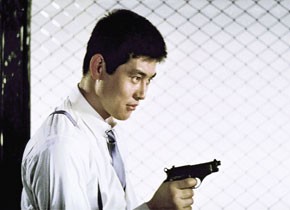Suzuki Seijun
April 12 to May 10, 2012
When speaking of Japanese “B” movies, one usually thinks of Suzuki Seijun, the eccentric visionary of genre cinema. But Suzuki is more the exception than the rule, or more exactly: he represents the point where of all of the themes, subjects and rules of this cinema come to a head – his work is subversively and joyfully excessive, a tempest in which Pop Art and Japanese traditions in staging and visual design meld together in singular fashion. Suzuki stands for a certain era, its aesthetics and culture of production, and at the same time, for its most deviant forms – a maître maudit, an eternal maverick, a loner, an anarchist.
Starting in the 1970s, Suzuki was the first Japanese genre filmmaker to be intensely discussed by international cinephiles. Since then, works of other giants in the field of Yakuza/Erotic/Action cinema (such as Katō Tai, Fukasaku Kinji, Kumashiro Tatsumi and Ishii Teruo) were also shown and debated in the West, but it was always the Suzuki’s films that attracted the most attention. This is not surprising – who would not be stunned and amazed upon watching Tokyo Drifter (1966), a kind of trademark film for Suzuki: gangsters in color-coordinated outfits, chasing each other through stylized backdrops as well as realistic landscapes that look as if they were constructed in a studio, shooting at each other until only one – anyone – survives. Similar only to Edgar G. Ulmer and Mario Bava, Suzuki embodies everything that is associated with the utopia of genre cinema: extreme flamboyance, the desire to experiment and break rules, a playful approach to the minimal means of production, and above all: the gift of self-irony.
For Suzuki Seitarō – as he was known when born in Tokyo in 1923 – life was simply absurd. At least, that was the core impression he took from being a soldier in the Fifteen Year War. The sinking of a ship upon which he was stationed during those years was an experience which would shape his world-view. All people are different, but at that moment they all ran closely together in the same direction: away from death, vainly, in many cases. Later, Suzuki would compare this sight with images from slapstick comedy. As a late child of the Taishō-Era (1912-26), the highpoint of a specifically Japanese modernism, this was not all that surprising for Suzuki, for he had grown up with the anti-heroic films of Itō Daisuke and the novels of Nakazato Kaisan, both early influences to which he later repeatedly referred.
Like almost every Japanese director of his generation, Suzuki also claimed to have landed in cinema by chance, primarily because he failed his entrance exam to the University of Tokyo. So, in 1946, he arrived as an assistant director (he passed this test) at Shōchiku; in 1954 he moved to the just re-opened Nikkatsu studio, along with many others – they knew that there they would soon get the chance to direct. In 1956, Suzuki debuted with the laid-back yet sharp melodrama Harbour Toast. Interestingly, Suzuki often knew for which A-list film his B-movie would be programmed, and thus he attempted with his "bottom-half underdog" to react to the respective "prestige" work – for example, Kanto Wanderer emerged as an accompaniment to Imamura Shōhei's Insect Woman (1963).
Kanto Wanderer was just one of four major works Suzuki created in his breakthrough year, 1963. His output up to this point was not insignificant – even before this annus mirabilis there had been several virtuoso exercises such as Voice Without A Shadow (1958) and Love Letter (1959). But the period from 1963-67 is generally recognized as Suzuki's glory days, culminating in three canonical works: Fighting Elegy (1966, about the fascist youth of the 1930s) and the gangster films, Tokyo Drifter and Branded to Kill (1967). The latter became a cause célèbre: the bosses at Nikkatsu fired Suzuki because they found him "incomprehensible" – he simply became too much for them. They hated everything which today accounts for the director's fame.
It was only ten years later that Suzuki was able to again work in cinema, thanks to the independent production and distribution company, ATG. Among these later films is the so-called Taishō-Trilogy; Zigeunerweisen (1980), Heat Shimmer Theatre (1981) and Yumeji (1991) – celluloid dreams from a man finally free to indulge his aesthetic appetites; a decadent-formalistic cinema, whose genius the world film culture has not yet fully embraced.
This first ever Suzuki retrospective in Austria is a project of the Film Museum, the Japan Foundation, the Nikkatsu Film Corporation and the Japanese Embassy in Vienna. It will be shown subsequently in other European cinémathèques and venues. As a Viennese Homage to the 89-year-old master, who can no longer travel, one of his favorite films will be screened: "Burgtheater" (1936), by the Austrian auteur Willi Forst. On April 13, film scholar and Japanologist, Roland Domenig, will present an introductory talk on Sukuki’s work.
